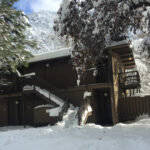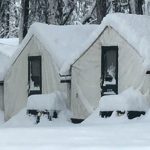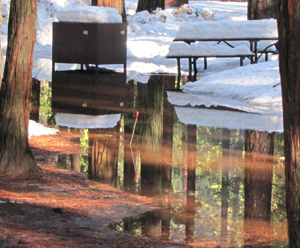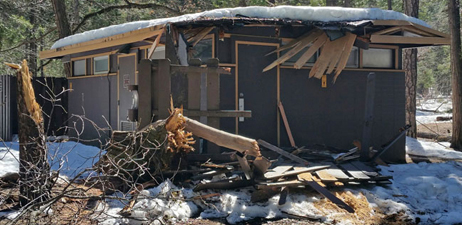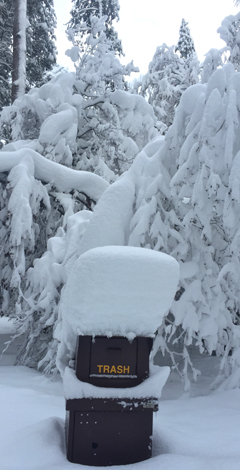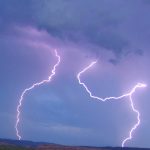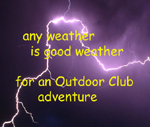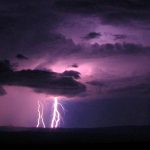Winter camping in Yosemite Valley is not a true wilderness experience. Some years there is lots of snow, some years we have found sunny early spring weather.
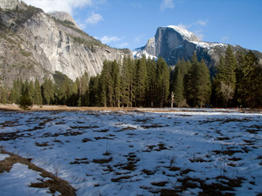
There are restrooms and they’re heated except during power outages. You’ve got a car to bring lots of stuff instead of just a backpack.
There are restaurants to bail to if an in-camp meal is a disaster or if you just don’t want to cook.
There is an emergency medical center a mile from the campground and a 24 hour ambulance service in the park.
Most trips have had two or more Red Cross first aid and/or CPR instructors on them, sometimes including someone who was/is an EMT or Paramedic.
The free shuttle bus runs most of the day/early evening, in all kinds of weather and stops at the hotels & campgrounds, restaurants, shower house, grocery stores, laundromat, visitor center… a second free bus goes to the ski resort/ranger snow shoe walk. If you don’t have a vehicle that can get to Yosemite, or you just don’t want to drive in the snow, take a look at public transportation to Yosemite.
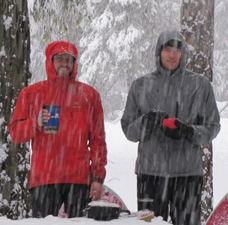
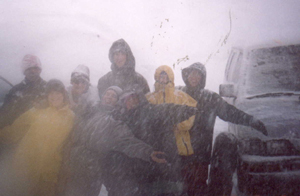
Rockfall is more likely in the winter.
Please believe the “must have” list for the trip at Snow or rain camp must-haves. You can get by (sometimes just barely) with the wrong gear in the summer, but not in the winter. The need for lots of non-cotton socks is so important.
From a NOLS (National Outdoor Leadership School) Wilderness case study: “cold, damp socks is not a sign of toughness, rather, it’s a bad habit.” Serious cold injuries to toes/feet can surprise “people who thought their feet were just a bit cold.”
The park service says: “Prevent hypothermia by managing clothing as needed. Take off a jacket before getting sweaty; warm up your fingers before they are too stiff to work a zipper. Dry winter air means you need more water to stay hydrated — don’t forget to drink because it’s cold out.”
Previous years we’ve found that if we all work together, and have a cooperative attitude,
then we can stick out any trouble or just have more fun.
The Park service says: “Group dynamics are even more important in winter. Do not separate from your group. Watch out for signs of hypothermia, exhaustion, or dehydration in others as well as yourself. Suspect hypothermia if you notice unusually slow movements, unintelligible speech, and peculiar behavior. If a member of your party appears hypothermic, take quick action to keep him or her as warm as possible. Make decisions based on the weakest party member”
That’s why so many pages at this site are required reading for anyone who goes on the trip. And that’s why we hope everyone will support the idea of everybody helping out everybody else.
Even if it’s good weather, it can change quickly, so tents in place with rain flies securely on should be one of our first priorities, if there are large number of people camping each group often helps the next arrivals to get settled.
As more people arrive, they will walk around and create paths through the snow (if there is much snow) from campsite to campsite to restroom, campfire, etc. This will make walking after dark much easier.
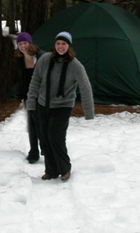
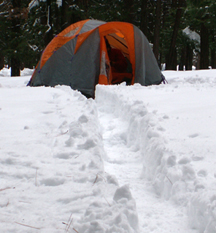
People staying in hotels or the tent cabins at Curry may find they they have to walk around and create paths as well, or at least spaces on stairs to walk:
If it has snowed a lot on and off for days, the total depth means that even when it’s stomped down, it can come to the height of a picnic table bench, so you’ll be walking around at bench height, and bending over a lot to use the table, unless you shovel under the table. (But this is rare in Yosemite Valley where we’ll be camping.)
Snow plows work on the main roads first and then get to the campground loop road, (or sometimes don’t have the time to get to the campground loop road). When they push each day’s snow to the side, it can make a wall in some places a couple of feet high. Some of these could be at campsite parking places, so you may have to shovel some snow to be able to park.
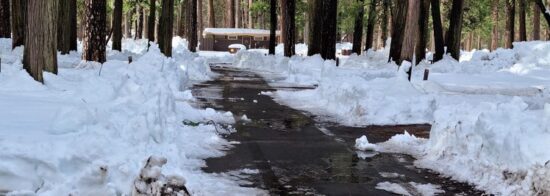
(Photo below is of the road into a closed-during-the-winter campground, so no, no one had to drive in that depth of snow.)
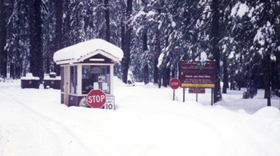
Sometimes you need a hatchet as well as a shovel to clear snow/ice from the top of a picnic table…
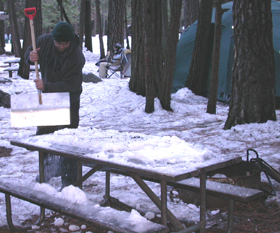
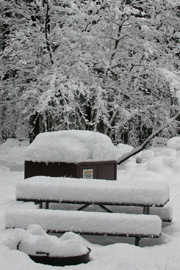
Even a thick layer of ice / snow slides off the top of a bear box fairly easily, so it might be where you start:
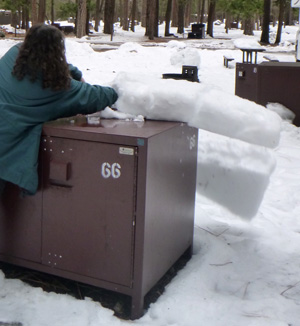
a picnic table can not only have snow that needs clearing, but a layer of ice beneath that needs more tools to remove it:
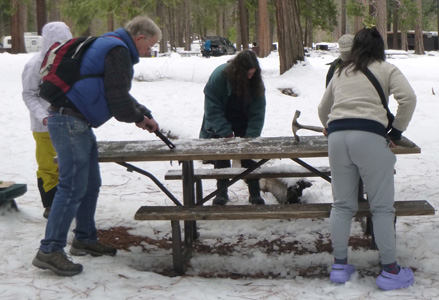
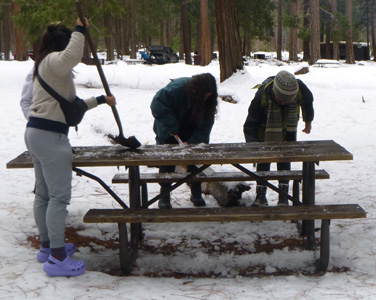
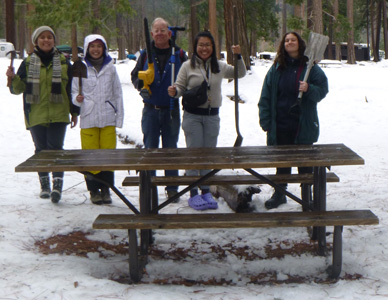
If we keep to our plan of mutual help, the last arrivals can expect to be met by lots of people (if we have a lot of people camping) with flashlights ready to stomp down any deep snow to a few inches in large spaces for the last tents (or maybe people will have anticipated the arrival of the bigger tents and already have spaces stomped).
The 1968 Cadillac sedan with maybe six inches of ground clearance will finally make it into a campsite parking space and everyone will enjoy the festival atmosphere of its arrival–if we all plan for and choose that atmosphere.
If it snows the last night, cars will need to have snow cleared from them. (You could have just left the vehicle to sit at the campsite / hotel for the weekend, and ride the free valley shuttle bus or ride the free bus to the ski resort/ranger snowshoe walk, or carpooled to the trailhead for the Upper Yosemite Fall hike.)
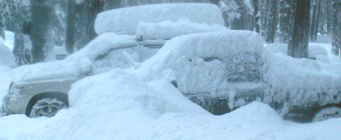 Clean the snow off the whole hood or it will slide and blow up on the windshield as soon as you drive off. Clean any snow out of the windshield air intake on the hood. Spray a little deicer on the windshield washer nozzles. Snow left on the roof will slide down on to the rear window, blocking visibility and the use of any rear wiper, or slide on the windshield the first time you hit the brakes. Clean any snow away from the exhaust pipe. Clean off all the lights. If you must bring some snow home for a snowball fight with your roommates, fill a now empty ice chest. (This advice is from: Prepare for winter driving.)
Clean the snow off the whole hood or it will slide and blow up on the windshield as soon as you drive off. Clean any snow out of the windshield air intake on the hood. Spray a little deicer on the windshield washer nozzles. Snow left on the roof will slide down on to the rear window, blocking visibility and the use of any rear wiper, or slide on the windshield the first time you hit the brakes. Clean any snow away from the exhaust pipe. Clean off all the lights. If you must bring some snow home for a snowball fight with your roommates, fill a now empty ice chest. (This advice is from: Prepare for winter driving.)
The main roads are often plowed right away but not the campground loop road. (Rarely the roads out of the park can all be closed for part of a day, so you should not have a tight schedule to get home.) We have had people with big four wheel drive vehicles drive around our campground loop to semi-plow the road. Then people might need only to shovel out a path to the road for their tires from the campsite parking space:
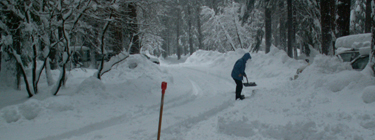
——————
No one should to go for hours with cold or numb toes because they’re too shy or too macho to speak up. If you forgot something, ask around. Someone might have brought a spare or maybe we can think of something that will do until morning when the stores open.
The success of this trip begins with each member of the trip understanding what to bring and what rules are special to Yosemite. It all begins by actually reading all the snow camp website pages, not just skimming through them.
There will be a written test to pass before you can sign up for the trip.
We require seeing your rain gear ( waterproof hooded rain jacket and rain pants big enough to fit over your warm stuff)
when you sign up.
If you don’t carry your raingear on a hike and it starts to rain, your clothes can get soaked through.
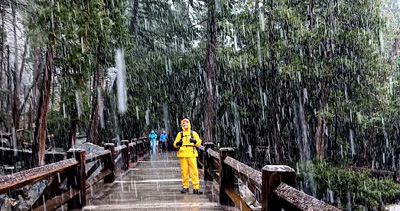
In the cold temperatures of the mountains, winter or not, you could die from exposure.
People on our club winter trips are required to carry their rain gear and a flashlight (electric torch) or headlamp at all times. (And brand new batteries in these are wise.)
Depending on a GPS unit to intentionally be separated from your hiking partners can lead to confusion or even disaster. Be certain that the people you are with are happy with this prospect.
Doing a night hike? In thick fog or blowing snow you will see better to hike/walk if you put your flashlight(electric torch) or headlamp on a belt at your waist instead of on your head. If it’s slippery, and it probably will be, people have gone on a night hike on the road to Mirror Lake arm-in-arm in groups of two or three or four or… okay, not twenty.
Safety tips for walking on icy surfaces from Yosemite National park they had for employees:
“Walking to and from parking lots or between buildings at work during the winter requires special attention to avoid slipping and falling. Slips and falls are some of the most frequent types of injuries – especially during the winter months. No matter how well the snow and ice is removed from parking lots or sidewalks, your employees will still encounter some slippery surfaces when walking outdoors in the winter. It is important for everyone to be constantly aware of these dangers and to learn to walk safely on ice and slippery surfaces.
Keep these important safety tips in mind:
– In cold temperatures, approach with caution and assume that all wet, dark areas on pavements are slippery and icy.
– During bad weather, avoid boots or shoes with smooth soles and heels. Instead, wear shoes or boots that provide traction on snow and ice; boots made of non-slip rubber or neoprene with grooved soles are best.
– Use special care when entering and exiting vehicles; use the vehicle for support.”
(Below a picture of a hotel parking lot, with slippery ice around each parking space. The parking lot lanes are snowplowed, but the parking spaces are not often snow-plowed) :
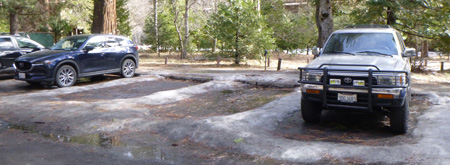
“- Walk in designated walkways as much as possible. Taking shortcuts over snow piles and other frozen areas can be hazardous. Look ahead when you walk; a snow- or ice- covered sidewalk or driveway, especially if on a hill, may require travel along its grassy edge for traction.
– Point your feet out slightly like a penguin! Spreading your feet out slightly while walking on ice increases your center of gravity.
– Bend slightly and walk flat-footed with your center of gravity directly over the feet as much as possible.
– Extend your arms out to your sides to maintain balance.
– Keep your hands out of your pockets. Hands in your pockets while walking decreases your center of gravity and balance. You can help break your fall with your hands free if you do start to slip.
– Watch where you are stepping and … go … slowly…!!!
– Take short steps or shuffle for stability.
– Wear a heavy, bulky coat that will cushion you if you should fall.
– Try to avoid landing on your knees, wrists, or spine. Try to fall on a fleshy part of your body, such as your side.
– Try to relax your muscles if you fall. You’ll injure yourself less if you are relaxed. (M. Grissom)”
Jackson Hole Wyoming Fire/EMS had this advice as well:
- If ice is unavoidable, slow down and shorten walking stride. Keep hands out of coat pockets to help with balance, and use handrails whenever possible.
- Don’t carry things in front of one’s line of vision. Instead, wear a backpack or hold items by one’s side to lower center of gravity.
- When getting out of a vehicle, use multiple points of contact. Grip the car’s door frame and either the steering wheel or the handle on the car’s frame.
The Yosemite Guide newspaper has had this warning about winter:
“Winter in Yosemite offers unique challenges.
Some trails are inaccessible or closed during the winter.
Trails that remain open may be covered in ice and snow, making hiking hazardous.
Even if the Valley floor is free of snow, expect to find it as you climb in elevation.
Ask about trail conditions before you go.
Carry trekking poles, warm, waterproof layers, and traction devices for your shoes.”
– This park service photo shows over-the-bottom-of-your-shoe foot traction devices. But the person on the left has short socks that do not go over her ankles, not recommended in the cold, whether our Yosemite trip has sunny weather or rain or snow… or all three.

Please remember to not wear traction devices into buildings or tents.
WEATHER
Many of our winter Yosemite valley trips have had mostly nice, sunny, cold weather with some snow on the ground (one year a settled foot and a half, one year only some patches of snow here and there). But we could have a repeat of 14 inches of snow in one night (followed by a gorgeous, sunny picture-perfect day). Other times we’ve had precipitation that fell as rain during the day, slush in the afternoon and snow at night.
One year there was enough rain to flood part of the campground, but since we know which campsites are most likely to flood we don’t camp in them. (As a courtesy to people not on our trip who might read this webpage, campsites 1 to 94 in Upper Pines Campground are usually the ones open during the winter. The campsites likely to flood during heavy rain are 13, 14, 45 and 46 in the first loop. They can be okay for people in motorhomes, but not for tent campers.)
Upper pines campsite #4 with a iced over shallow pond in the parking space:
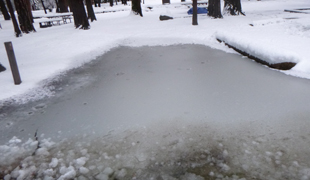
Average temperatures in Yosemite in January are a high of 49 and a low of 26, February high 55, low 28. We regularly have freezing temps overnight.
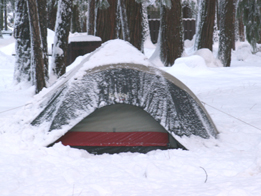
One year when everyone camped a bunch of the campers decided they had enough weather the first night, and they got cabins for the second night. They complained that they were not warm enough in the tents (but they also later complained that the cabins were too warm). The advisor, of course, stayed in the campground. The rest of the students who stayed to camp seemed proud of themselves. I can still remember lying in my sleeping bag, just starting off to sleep. The wind was busy in the trees and a really big burst of hail hit us…others in our group started cheering.
As the snow builds up on the cliffs, we’ve heard small and large avalanches coming down off the cliff walls, some only minutes apart at night (a good reason to do night hikes close to the campground/main road, not close to cliff walls).
John Muir: “After every heavy snow-fall, numerous avalanches are born upon all of the slopes and cantildeons of suitable steepness. In general appearance they resemble waterfalls of the highest free-falling kind, being like them, close, opaque, white in color, and composed of companies of comets shooting downward with unequal velocity, amid a casing atmosphere of whirling dust.”
Sleet, wind and other “interesting” weather (including snow that bites at your face if you are out in it – wear a balaclava or a scarf wrapped around your face) are also possible, but rare (weather does not cancel Outdoor Club events unless the Rangers say to move or go home).
Even with early-spring-type weather and very little snow on the ground at the campsites it is always quite cold at night. You will not get much sleep without at least one insulating pad under you. We advise at least two, maybe on top of an air mattress (the kind you float on in a pool), but not just an air mattress by itself!
There is a slight chance of our experiencing the “Mono winds.” These are up to 70 m.p.h. and have knocked down trees.
A previous news flash from the park service said: “High Wind Warning Until Noon Tomorrow
A high wind warning is in effect until Saturday at noon. High winds (gusts up to 55 mph) are expected throughout the park. Stay indoors during periods of high winds. Road closures due to downed trees or unsafe conditions are possible. Badger Pass Road and all campgrounds are temporarily closed.”
At the start of past Mono winds the Rangers moved people from the campground to the Curry Village parking lot, site of an old apple orchard, so no tall trees would threaten campers. They also moved people from their hotel rooms and cabins into the cafeteria, etc. One year the winds were high until 2 a.m. and only the campers got sleep; the hotel guests were kept from their rooms.
This means the possibility of no picnic tables or fire rings, so bring lots of lunch box-type food and trail snacks, so you can eat a cold dinner if necessary. Then just plan on spending the evening in your tent solving the world’s problems, reading magazines or playing board games or cards while the storm whirls around you.
- Previous Mono winds we have experienced lasted only part of one day, not a whole weekend.
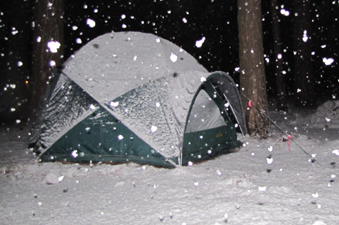
When you look at the weather report in advance of the trip, please note it can change quickly, and note that Yosemite valley is about 4,000 feet elevation and the Badger Pass Yosemite ski resort is 7,200 to 8,000 feet elevation. When it is raining in Yosemite valley it can be snowing at the ski resort and snowing part way up a trail you might choose to hike (the top of upper Yosemite Falls is at 6,400+ feet).
At the end of the 2019 trip it started snowing heavily “SNOWZILLA“. . . and for 2 1/2 days all roads out of Yosemite Valley were closed and all campgrounds were closed due to risk from falling trees, but the students got out just in time.
Here, a NPS photo of the result when a large tree broke in half and fell on a campground restroom, closing it for weeks (the campground had already been closed in anticipation of the storm, so no one was in the building when the tree fell on it):
and one night of snow:
FIRST AID CONSIDERATIONS
If you spill liquid fuel on your hands when handling a camping stove in the cold, you can get instant frostbite when it evaporates quickly. The fuel can damage or permanently wreck your fancy tent fabric, or your fancy clothing, so refuel at home before the trip and if needed during the trip, refill carefully outside of the tent.
Accidental burns or carbon monoxide poisoning from cooking inside a poorly ventilated tent are distinct possibilities, so no cooking in the tents.
__________________________________
We have so many options for cooking (or not cooking – just having snack-type food) and people bring so much foul weather gear, that the need to cook in a tent will not arise, but here FYI, from a medical study of carbon dioxide poisoning in tents:
A comparison of carbon monoxide levels during the use of a multi-fuel camp stove
from the Wilderness Medical Society,
“The use of camp stoves in an enclosed or poorly ventilated space is clearly not recommended due to the risk of carbon monoxide (CO) poisoning. Instances may arise, however, when use for a limited time is necessary. We sought to find differences in CO levels between various fuels used to power a commercially available camp stove.” They found that all the fuels they tested “created a high level of CO in a short period of time.”
__________________________________
While out in the weather keep an eye on each others’ noses, ear lobes and fingers. Often the person with frostbite starting won’t notice it, but a partner will notice color change to white, waxy or grey and mottled. You’ll be busy having fun, so you need to think to stop once in awhile and think about your skin and wiggle your toes. Remember, wherever you get frostbite, you will be very susceptible to getting it in the same place again.
Shivering is your body’s last line of defense against hypothermia, so never ignore it in yourself or a friend. But you can get hypothermic without shivering, so watch out for partners who seem to have become clumsy walking or on their skis, often a first sign of major trouble.
Some people think that because alcohol makes you feel warm it would be a good idea in the outdoors in the cold. The reason drinking beer or stronger alcohol makes you feel warm is that it dilates blood vessels next to your skin. It makes them bigger, so more blood moves next to your skin, and more warm blood means you feel warmer. BUT you are also losing crucial inner core body heat at an alarming rate. So you are actually getting colder even though you have the sensation of being warmer.
— USE OF ALCOHOL IN THE COLD KILLS.
There is often no first aid to be given.
ANIMALS
There are mountain lions in Yosemite. At least 18 in a 2003 report and warnings of multiple reports in Yosemite Village in a Daily reports of 2016, 2018, 2019 and 2020.
and in early 2018 “Mountain lion behavior indicates that the main draw to Old El Portal is easy prey – dogs and cats.”
“By allowing your pets outside in mountain lion habitat not only are you putting your pet at risk, but by attracting large predators to housing areas you are also putting children and other people at a higher risk. Once a mountain lion discovers easy prey, they are likely to hang out looking for more. When this prey is within a residential area, this can lead to a bold mountain lion used to human presence.”
You will probably not see one but please read the most current information about what to do in the Yosemite Guide newspaper, which you can get when you enter the park or read at:
http://www.nps.gov/yose/planyourvisit/guide.htm.
From the park website and a Daily Report:
“Lions are a normal and important part of Yosemite, however, the presence of lions, especially near developed areas, requires that we take precautions.
While the chances of lion attack are very low, they can be further reduced by following some simple precautions:
– Keep children close to you when outside. Don’t let them run ahead or lag behind.
– Never feed wildlife
– Do not hike or run alone, especially after dark. A walking stick can be useful defense.
– Be alert and aware of your surroundings, by visually scanning along the trail ahead and behind.
If you encounter a lion:
– Remain calm. Don’t run! Lions instinctually chase running prey. Pick up or restrain small children to keep them from panicking and running.
– Do not turn your back on the lion. Maintain eye contact, and stand your ground or back slowly away.
– Talk to the lion in a loud, firm, confident voice.
If a lion moves toward you, does not move away, or behaves aggressively:
– Try to appear as large as possible, by holding your coat open, or raising and waving your arms. Avoid crouching down, or bending over.
– Maintain eye contact with the lion and yell in a loud, low voice.
– If with others, stand together to give a more imposing impression.
– Arm yourself. Pelt the lion with rocks and sticks. Your goal is to convince the lion that you are not prey, and that you are a danger to it.
– Never run!
If a lion attacks:
– Fight back!
Attack from a mountain lion is an extremely unlikely event, but use of the above recommendations can further reduce the chances of injury and allow humans to more safely share the park with these spectacular animals.
Report mountain lion sightings to yose_bear_mgmt@nps.gov or to the Park’s Dispatch Office at 1 209 379-1992.”
Below: on the way back from an early morning walk to Mirror Meadow we found cougar tracks crossing our path that had not been there on the way in. A coyote’s or dog’s tracks would have had distinct claw marks, so this must have been a big kitty.
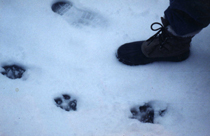
See also: Bears
Rattlesnakes.
Safe bat encounters
TRAIL SAFETY NOTES
Winter trails, as well as sidewalks and parking lots, are sometimes icy or slippery, so wear high traction boots or shoes (not flat-soled street shoes).
Be prepared for big weather changes. You might find warm conditions at mid-day and be hiking in a tank top, only to need all your layers and wet/windy weather gear an hour later.
When hiking trails along cliff walls be prepared for chunks of falling rocks, ice or snow.
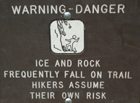
The Mist Trail is always closed during most of the winter between its junction with the John Muir Trail a couple of bends past the Vernal Fall Footbridge and the top of Vernal Fall (the stairs area of the Mist Trail) It is closed because of of “the hidden hazard of ice falling onto the trail from above.”
The Four Mile Trail to Glacier Point and the John Muir Trail between Clark Point and the top of Nevada Fall are always closed for the winter.
(I asked a spokeswoman at the Wilderness Center why the Four Mile Trail is always closed but the John Muir bypass portion of the Mist Trail is often open. She said there are very slippery portions and even avalanche chutes on both trails that could catch the unprepared and inexperienced, but the slide off the Nevada Falls route would only send you down about 40 feet; the slide off the Four Mile Trail would send you all the way down to the valley.)
The Half Dome cables are always down for the season. The Rangers really don’t want to do a winter night time rescue and therefor don’t want anyone to try to do the Half Dome trail in winter.
Other trails may be open, but we can still expect some potential ice fall.
The club requests that any hikers who go above the valley floor, or any distance from the shuttle bus route, or any cross-country skiers away from the heavily used areas at Badger (ski area) go in groups of four or more in case of problems. It’s much better to leave one person with the hiker with the sprained ankle, and have two go out together for help, than to face emergencies with only two people. You can start out in the morning in fabulous sunny weather, and be totally immersed in winter before noon.
If the trail is clear enough, we almost always hike the trail from the valley to Columbia Rock and beyond to at least the base of upper Yosemite fall. Some people go beyond to the top of upper Yosemite fall. Along the way, near the base, if you are in good shape and careful, you can go off trail (please, only about ten feet, stay among the giant boulders) into a big section of boulders and see the falls up closer. We have gotten great pictures of the rainbow in the falls and closeups of the snowcone with telephoto lenses.
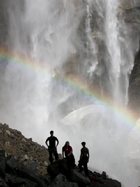
People have had to be rescued from the trail. One guy (not from our trip) in 2012 “slipped on a step covered by decomposed granite (very fine gravel). While one leg slipped forward, the subject’s other leg slipped backward, forcing the subject to do the splits. The subject was wearing tennis shoes with slick bottom soles… While traveling downhill on steep sections of trail, slipping on gravel is common. Wearing trail shoes, hiking boots or footwear with sticky rubber soles can help hikers maintain traction on the park’s tails; some hikers also use http://www.nps.gov/yose/planyourvisit/guide.htm to help with balance and avoid slipping.”
In another rescue report the park said “scrambling off trail is one of the leading causes of serious injury and death in Yosemite”. People on the Yosemite Falls hike are often go a bit off trail to see better views of the rainbow/snowcone. A bit off trail is the farthest they should go, trying to go all the way down to where the waterfall flows is risking too much.
Quoted parts above are from http://www.nps.gov/yose/blogs/Lessons-Learned-2012-Last-post-for-the-season.htm
Unfortunately, some people don’t stay in the relative safety of the boulders area and they die doing this.
Yosemite National Park news releases described three such deaths (as paraphrased below).
1) A twenty year old guy was hiking with four friends on the Yosemite Falls Trail. He and one other person stopped at the base of the Upper Yosemite Fall. The pair scrambled down into the basin at the bottom of the waterfall, when he slipped and stumbled, falling 40 feet to his death. The National Park Service’s Search and Rescue team responded by helicopter to the incident. He was pronounced dead at the scene about 1:30 p.m., having suffered a head injury.
2) A 23 year old man died while hiking off-trail on the Yosemite Falls trail. He fell into Yosemite Creek. The accident, which occurred around 1 p.m., was reported to rangers at about 2 p.m. by friends who hiked back down the 3.6 mile trail. The young man, hiking alone, had apparently been trying to get to the edge of Yosemite Creek when he slipped and tumbled approximately 100′ before landing in the creek. His body was not retrieved by a rescue crew until 5 p.m. About 20 rescue workers flew into the area by helicopter and then swam in a pool of water to recover his body in a pool in the rough, middle section of the Yosemite Falls. The preliminary cause of death appears to be drowning.
3) two Boy Scouts were hiking on the Yosemite Falls trail, approximately 300 yards above Columbia Point…left the trail and attempted to take what they believed was a short cut. Both boys fell due to the steep terrain. One of them was able to self-arrest after a drop of approximately 10 feet, but saw that his companion continued over the edge and fell about 300 feet. The victim was located by rangers at the bottom of the cliff in an area just west of the Munginella climbing route. Advanced life support measures were employed for approximately 15 minutes before the boy was pronounced dead. A preliminary finding of the investigation into the incident by investigators and the medical examiner has ruled the death as accidental.
You can read more at the DROWNING / WATERFALLS / SLIPPED, FELL section at: fatal, near fatal or close call incidents/accidents in camping, backpacking, climbing and mountaineering
To prevent this from happening to you on our trip,
- stay with a group of at least four people, either everybody goes (slightly) off trail, or no one does (with four people there is one to stay with someone injured and two to go out for help if cell phones don’t work, and they often don’t work).
pump water to drink at one of the creeklets that come down the mountain along the true trail, never by trying to get down to Yosemite Creek/falls itself,
if you go off trail, go only a few yards, stay high up in the boulder fields well above the falls/creek
use a telephoto for the close up shots
SOME THOUGHTS ON HIKING TOGETHER AND DEPENDING ON EACH OTHER.
We require that people hike in groups of four or more on our winter trip. It’s hard to get lost on the hiking trails or especially the groomed ski trails in Yosemite, so your survival will probably not be on the line. But some rules for real wilderness travel still apply.
Be sure you and your hiking/skiing partner (or group) have the same goal. Will you be taking your time, taking pictures, listening to the snow fall? Or do you have a specific destination within a certain time limit? Will you keep to obvious trails or try cross country? If you don’t all agree before you start, maybe you should be in different groups.
Remember that sometimes the time to turn back is before you leave. If you’ve planned on spending 100% of a trip with your best friend or future spouse, re-think it. One morning it may be important for one person to tell the other: “I want to rest today and hang around camp, so you go on the day hike to Overly-High Peak with the others.” The best way to say this is to not make your partner feel as though he is abandoning you.
If you want to risk life and limb on a foolish adventure on your own, do it on your own time. It’s uncool to commit to a group ski/hike and then announce “I won’t be going back with the rest of you; I’ve decided to climb Screaming Glacier on my own without proper equipment to show how macho I am.” This leaves your companions feeling responsible if they don’t watch out for you.
Be honest. Don’t be too proud to admit you have a pulled muscle or numb toes and need help, or to say something looks too dangerous. When your partner or someone in your group is honest with you, take them at their word. Help the person with the pulled muscle without bruising their ego and making them wish they’d kept quiet. Never pressure someone into trying something that looks too dangerous to them.
But know the exceptions to the above. Sometimes you have to do something risky because there is a greater risk if you don’t. First aid smarts say don’t take someone you suspect of being hypothermic at their word when they say they’re OK.
To rephrase some of the “Climbing Code” of the Mountaineers Club of Washington:
Carry all the necessary clothing, food and equipment at all times.
Behave at all times in a manner that reflects favorably on mountaineering.
Never let judgement be overruled by desire
when deciding to turn back.
On summer trips the club has had people who ignored the safety stuff, and other people took care of them. This is winter. People will probably be nice and help you out no matter how reckless or unprepared you are. But they will have read this trip info and won’t be real convinced if you try too many excuses. And most will carry only enough gear for themselves and not want to share, so it is a good thing when we meet before a day long hike for everyone to be ready to show the rest of the group their waterproof outerwear, flashlight or head lamp, large quantities of water and lunches / snacks they are bringing so everyone can have confidence in traveling with each other.
“There are no scheduled winter patrols, so be prepared…Plan your trip sensibly anytime you go out, keeping in the mind the experience level and conditioning of the weakest member of your group.
Don’t separate from other members!
Winter backcountry travel is almost always trickier than summer
–conditions are unpredictable and variable,
trails are slippery or hidden, visibility can be poor,
and landmarks look very different under snow.
New hazards such as falling rock or ice, snow bridges, or hollow spots under the snow pack can cause problems.
Remember there is less travel time due to shorter days and more obstacles to speedy movement than in summer. Make sure someone knows where you are going and when you are due back…”
“The Wilderness Safety Action Team would like to remind you that when you
work or play outside in the winter, remember that the weather is often
unpredictable. If you are going out for the day, check the forecast, but
be prepared for both ends of the weather spectrum each time you go out.
Carry sunglasses, sunscreen and a hat for shade particularly if there is
snow on the ground, but also carry storm gear and warm clothing. You lose
much of your body’s heat from your head, so a warm hat is a necessity.
Remember you need to eat and drink more to prepare yourself for cold
weather activities–you need a gallon of fluids a day during strenuous winter activity.
Creeks will be frozen, so tank up by drinking as much as you can before leaving and carry a couple of quarts of water for a full days outing.
Be prepared to spend an unexpected night out when traveling in the
wilderness. If you get lost, or must bivouac, stay put and stay dry.
Carry a lighter to build a fire–lower tree branches are often dead and
dry. Look for pitch on tree trunks for fire starter. Boughs can be used
for a platform in an emergency, and you can insulate yourself from the wind
and snow by huddling together and sitting on packs or ensolite pads. A
shelter can be made by digging a trench in the snow. Three blasts on a
whistle, repeated often, will help searchers find you. Stomp out a big “X”
in the snow to help the helicopter find you if things go that far.
This information is to help you stay safe by providing easy ways to stay
out of trouble. Proper preparation and thought can prevent everything from
unpleasant experiences to rescues, and allow you to spend your time
enjoying the great outdoors comfortably and safely. (L. Boyers)”
Here are more rockfall safety tips from the Wilderness Safety Action Team.
This text is from the official wording on the rock fall closures posted at trail barricades, but applies to all of us, all the time.
ROCKFALL POTENTIAL IN THE PARK
Rocks and/or ice can fall at any time. While hiking trails, avoid
lingering near talus or steeper slopes, particularly in winter. If you
observe a rockfall in the area, call 911 or 209/379-1992 with information
on the time, location, and duration of the event.
BE RESPONSIBLE – BE SAFE
Rockfalls are a dynamic – and dramatic – natural process. But it is impossible
for the park to monitor for every potential rockfall. In Yosemite, and in
any natural area, it is up to visitors and employees alike to be aware of
their surroundings and enjoy the park safely.
Rockfalls are dangerous and can cause injury or death. Use caution when
entering any area where rockfall activity may occur, such as Valley walls,
climbing areas, or talus slopes.
LEARN MORE
Winter is one of the most active periods for rockfall activity in Yosemite
National Park. As temperatures fall in the evening and warm up during the
day, cracks in the granite can widen, eventually causing rocks to separate
and fall.
To learn more about rockfalls and geology in Yosemite National Park, stop
by any visitor center for an information sheet or visit online at
www.nps.gov/yose. (L.Boyers)
Yosemite rock falls from the Yosemite Daily Report
There is more info at:
Prepare for winter driving has a link to bad weather driving tips, tips for using tire chains, tricks for dealing with frozen car locks, how to prepare your vehicle for winter driving, a winter survival kit for your car and what to do if you get stranded.
Things to do during a Yosemite snow storm besides hiding in your tent
NOAA weather radio in Yosemite is found at 162.450 MHz.
A NOAA wind chill chart with frostbite times can be found at:
https://www.weather.gov/safety/cold-wind-chill-chart
see also: Cell phones in the wilderness which has advice on how/when to use a cell phone to contact 911 in the wilderness and a warning about interference between cell phones, iPods and avalanche beacons.
Yosemite Search and Rescue, lessons from the field:
http://www.nps.gov/yose/blogs/psarblog.htm
John Muir described snowstorms:
“darkness began to gather for a chapter of snow; heavy cloud-masses rolled down the black-washed walls, circling cathedral rocks and domes, and hiding off all the upper brows and peaks. Thin strips of sunshine slid through momentary seams that were quickly blinded out. The darkness deepened for hours, until every separating shade and line were dimmed to equal black, and all the bright air of our gulf was sponged up, and fastened windless and pulseless in universal cloud.
“It’s bound to snow,” said a mountaineer to me, as he gazed into the heavy gloom, “bound to snow when it gathers cloud material gradual as this. We’ll have a regular old-fashioned storm afore long.” Scarce had he delivered himself of this meteorological prophecy, ere the beginning flakes appeared, journeying tranquilly down with waving, slow-circling gestures, easy and confident as if long familiar with the paths of sky. Before dark they accomplished a most glorious work of gentle, noiseless beauty.
Twelve inches of snow fell during the night and when morning opened our temple, there was more of beauty than pen can tell—from meadow to summit, from wall to wall, every tree and bush, and sculptured rock was muffled and dazzled in downy, unbroken, undrifted snow. Transparent film-clouds hung in the open azure or draped the walls, the gray granite showing dimly through their fairy veil.
…one of the most picturesque snow storms I have ever seen. It was a tranquil day in Yosemite. About midday a close-grained cloud grew in the middle of the valley, blurring the sun; but rocks and trees continued to caste shadow. In a few hours the cloud-ceiling deepened and gave birth to a rank down-growth of silky streamers.
These cloud-weeds were most luxuriant about the Cathedral Rocks, completely hiding all their surnmits. Then heavier masses, hairy outside with a dark nucleus, appeared, and foundered almost to the ground. Toward night all cloud and rock distinctions were blended out, rock after rock disappeared, El Capitan, the Domes and the Sentinel, and all the brows about Yosemite Falls were wiped out, and the whole valley was filled with equal, seamless gloom. There was no wind and every rock and tree and grass blade had a hushed, expectant air.
The fullness of time arrived, and down came the big flakes in tufted companies of full grown flowers. Not jostling and rustling like autumn leaves or blossom showers of an orchard whose castaway flakes are hushed into any hollow for a grave, but they journeyed down with gestures of confident life, alighting upon predestined places on rock and leaf, like flocks of linnets or showers of summer flies. Steady, exhaustless, innumerable. The trees, and bushes, and dead brown grass were flowered far beyond summer, bowed down in blossom and all the rocks were buried. Every peak and dome, every niche and tablet had their share of snow.
And blessed are the eyes that beheld morning open the glory of that one dead storm. In vain did I search for some special separate mass of beauty on which to rest my gaze. No island appeared throughout the whole gulf of the beauty. The glorious crystal sediment was everywhere. From wall to wall of our beautiful temple, from meadow to sky was one finished unit of beauty, one star of equal ray, one glowing sun, weighed in the celestial balances and found perfect.”
Those rumors about the dining conditions on club winter trips are unfounded.
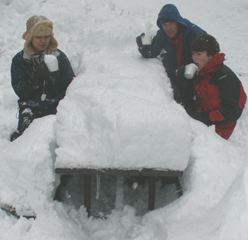
——————————————————————-
The author of this webpage, (written as a reading assignment for my students), does not give any warranty, expressed or implied, nor assume any legal liability or responsibility for the accuracy, completeness, or usefulness of any information, product, or process included in this website or at websites linked to or from it. Users of information from this website assume all liability arising from such use.
